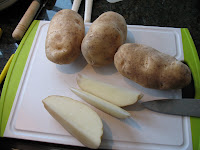
The Ballymaloe Cookery School is in the middle of an organic farm, including an herb garden, greenhouses, free range chickens, dairy and beef cattle, among many other things. Darina Allen, the head of the school, is a big proponent of the "Slow Food" movement (she is the Councillor for Ireland in that organization).

Given that background, it's no surprise that Darina supports people growing and raising their own food, including chickens. (She very generously gives people like me who live in high-rise apartment buildings with no balconies dispensation to buy instead.) One of the highlights of the 3-day course I took was jointing a whole chicken, which yields enough food for more than a week for someone like me.
As she pointed out--multiple times,in fact--a single whole chicken will yield 2 each of breasts, wings, thighs, drumsticks, as well as chicken skin (good for baking until crispy), wingtips, neck, and bones suitable for stock, and liver for pate (which I don't personally care for, but I'm sure other people like). A whole organic chicken can cost about $22-$26 (about $5.49 a pound), compared to $4-$5 (at about .99 cents a pound, sometimes it's as little as .49 cents) for a whole standard chicken. Whole chickens also tend to keep better longer, at least before you portion it out. Now that I've actually jointed a whole chicken, I can't see buying chicken breasts unless I'm pressed for time.

One thing I'm dead envious of at Ballymaloe is all the lettuce, vegetable, and herb garden space they've got. I can't help but think it would be much easier to eat better and more varied salads on a regular basis if I had access to this kind of facility in Boston. (Well, as long as I am wishing, I'd like a staff of a prep cooks like they had at Ballymaloe as well. I did try to grow some hydroponic herbs in my apartment and all I got was mice.) The salads they served with lunch at Ballymaloe were excellent, full of enough different types of lettuce and herbs for a variety of texture and flavor. I'm sure it helped that we were there in mid-July.

Ballymaloe also grows nearly a dozen different varieties of heirloom tomatoes, which I can tell you are delicious. I have some pictures of the resulting tomato salad Darina's team prepared, which I'll put up in a future post. It is prepared with all of the tomatoes dressed and served in a single layer, to avoid having to toss the tomatoes and break them up.


Ballymaloe grows enough onions, shallots, and garlic for their own use as well as distribution to some local programs. They hang them from the rafters, tops still attached, to dry in small bunches of no more than 4, to avoid bruising and rotting. The gardener--Darina's husband--contended that letting the vegetables and herbs dry with the leaves still on helps to retain nutrients and flavor in the bulb part of the plant. I won't argue--the results look and taste gorgeous.
Coming up next: more about the cooking demonstrations and lessons at Ballymaloe Cookery School (and maybe a recipe or two...)

 Normally in late June and early July, I would be trying to make my favorite grilled "puzzle" potatoes. (Take a potato, slice it crosswise into verrry thin pieces, keep the potato slices assembled in their original order, add a pat of butter, salt, and pepper, wrap in aluminum foil, and grill.) However, so far summer has very much failed to deliver in the weather-appropriate-to-grilling department, so, I tried a Cook's Illustrated alternative--oven fries. They came out great! These pictures really don't do them justice.
Normally in late June and early July, I would be trying to make my favorite grilled "puzzle" potatoes. (Take a potato, slice it crosswise into verrry thin pieces, keep the potato slices assembled in their original order, add a pat of butter, salt, and pepper, wrap in aluminum foil, and grill.) However, so far summer has very much failed to deliver in the weather-appropriate-to-grilling department, so, I tried a Cook's Illustrated alternative--oven fries. They came out great! These pictures really don't do them justice. Ingredients
Ingredients Directions
Directions 2. Drain potatoes. Spread potatoes out on triple layer of paper towels and thoroughly pat dry with additional paper towels. Rinse and wipe out now-empty bowl; return potatoes to bowl and toss with remaining 1 tablespoon oil. Arrange potatoes in single layer on prepared baking sheet; cover tightly with foil and bake 5 minutes. Remove foil and continue to bake until bottoms of potatoes are spotty golden brown, 15 to 20 minutes, rotating baking sheet after 10 minutes. Using metal spatula and tongs, scrape to loosen potatoes from pan, then flip each wedge, keeping potatoes in single layer. Continue baking until fries are golden and crisp, 5 to 15 minutes longer, rotating pan as needed if fries are browning unevenly.
2. Drain potatoes. Spread potatoes out on triple layer of paper towels and thoroughly pat dry with additional paper towels. Rinse and wipe out now-empty bowl; return potatoes to bowl and toss with remaining 1 tablespoon oil. Arrange potatoes in single layer on prepared baking sheet; cover tightly with foil and bake 5 minutes. Remove foil and continue to bake until bottoms of potatoes are spotty golden brown, 15 to 20 minutes, rotating baking sheet after 10 minutes. Using metal spatula and tongs, scrape to loosen potatoes from pan, then flip each wedge, keeping potatoes in single layer. Continue baking until fries are golden and crisp, 5 to 15 minutes longer, rotating pan as needed if fries are browning unevenly.